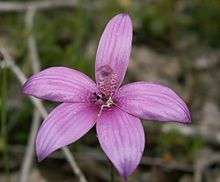Caladenia emarginata
| Pink enamel orchid | |
|---|---|
 | |
| Caladenia emarginata growing near Kirup | |
| Scientific classification | |
| Kingdom: | Plantae |
| (unranked): | Angiosperms |
| (unranked): | Monocots |
| Order: | Asparagales |
| Family: | Orchidaceae |
| Subfamily: | Orchidoideae |
| Tribe: | Diurideae |
| Subtribe: | Caladeniinae |
| Genus: | Caladenia |
| Species: | C. emarginata |
| Binomial name | |
| Caladenia emarginata (Lindl.) Rchb.f. [1] | |
| Synonyms[2] | |
|
| |
Caladenia emarginata, commonly known as the pink enamel orchid, is a plant in the orchid family Orchidaceae and is endemic to the south-west of Western Australia. It is a ground orchid with a single flattened, hairy leaf and up to four glossy pink flowers. It is similar to Caladenia brunonis but is usually a shorter plant but with larger, pink flowers. It has been known as Elythranthera emarginata since 1963 but recent discoveries suggest its inclusion in the genus Caladenia.
Description
Caladenia emarginata is a terrestrial, perennial, deciduous, sympodial herb with a few inconspicuous, fine roots and a tuber partly surrounded by a fibrous, multi-layered protective sheath and often forms colonies. It has a single flattened, dark green, hairy leaf, 20–80 mm (0.8–3 in) long and about 7 mm (0.3 in) wide with a reddish base. Up to four glossy pink flowers 30–50 mm (1–2 in) long and wide are borne on a spike 120–250 mm (5–10 in) tall. The sepals and petals spread apart from each other and are blotched with red or purple on their backs. The dorsal sepal is erect, 16–23 mm (0.6–0.9 in) long and 6–8 mm (0.2–0.3 in) wide. The lateral sepals have similar dimensions to the dorsal sepal and the petals are 14–20 mm (0.6–0.8 in) long and 6–8 mm (0.2–0.3 in) wide. The labellum is membranous, 4–5 mm (0.16–0.20 in) long, about 1.5 mm (0.06 in) wide and whitish with its tip twisted into an S-shape. At the base of the labellum there are two fleshy, dark purple, club-shaped parallel calli 5–7 mm (0.2–0.3 in) long. Flowering occurs from October to December.[3][4][5]
Taxonomy and naming
The pink enamel orchid was first formally described in 1839 by John Lindley who gave it the name Glossodia emarginata and published the description in A Sketch of the Vegetation of the Swan River Colony.[6][7] In 1871, Heinrich Reichenbach changed the name to Caladenia emarginata[8] and in 1963, Alex George changed it to Elythranthera emarginata.[9] In 2015, as a result of studies of molecular phylogenetics,[10] Mark Clements changed the name to back Caladenia emarginata. The specific epithet (emarginata) is a Latin word meaning "notched at the apex"[11] referring to the two labellum calli.[4]
Elythranthera emarginata is regarded as a synonym of the name Caladenia emarginata which is accepted by the Royal Botanic Gardens, Kew.[12]
Distribution and habitat
Caladenia emarginata is found as far north as Jurien Bay and as far east as Ravensthorpe, often forming colonies or clumps in swamps, near creeks and in dense heath.[3][4][5][13]
Conservation
Caladenia emarginata is classified as "not threatened" by the Western Australian Government Department of Parks and Wildlife.[13]
References
- ↑ "Caladenia emarginata". World Checklist of Selected Plant Families (WCSP). Royal Botanic Gardens, Kew.
- ↑
- 1 2 Jones, David L. (2006). A complete guide to native orchids of Australia including the island territories. Frenchs Forest, N.S.W.: New Holland. pp. 31–32. ISBN 1877069124.
- 1 2 3 Brown, Andrew; Dundas, Pat; Dixon, Kingsley; Hopper, Stephen (2008). Orchids of Western Australia. Crawley, Western Australia: University of Western Australia Press. pp. 244–245. ISBN 9780980296457.
- 1 2 Hoffman, Noel; Brown, Andrew (2011). Orchids of South-West Australia (3rd ed.). Gooseberry Hill: Noel Hoffman. p. 209. ISBN 9780646562322.
- ↑ "Glossodia emarginata". APNI. Retrieved 16 April 2017.
- ↑ Lindley, John (1840). A Sketch of the Vegetation of the Swan River Colony (PDF). London: James Ridgway. pp. 50–51. Retrieved 16 April 2017.
- ↑ "Caladenia emarginata". APNI. Retrieved 16 April 2017.
- ↑ "Elythranthera emarginata". APNI. Retrieved 16 April 2017.
- ↑ Clements, Mark A.; Howard, Christopher G.; Miller, Joseph T. (13 April 2015). "Caladenia revisited: Results of molecular phylogenetic analyses of Caladeniinae plastid and nuclear loci". American Journal of Botany. 102 (4): 581–597. PMID 25878091. doi:10.3732/ajb.1500021.
- ↑ Brown, Roland Wilbur (1956). The Composition of Scientific Words. Washington, D.C.: Smithsonian Institution Press. p. 562.
- ↑ "Elythranthera emarginata". Kew. Retrieved 16 April 2017.
- 1 2 "Elythranthera brunonis". FloraBase. Western Australian Government Department of Parks and Wildlife.